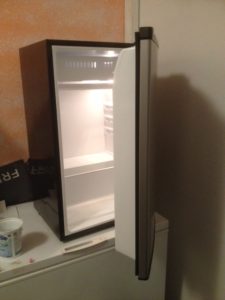With every technique and system there is a good way to do it and there is a not so good way to do it. It is the same for various techniques used to safely overwinter bee cocoons. There are 3 main things to keep in mind when storing mason bees:
- Keeping predators from eating bee cocoons
- Preventing bee cocoons from drying out
- Preventing bees from coming out earlier and or in the wrong place (like a storage shed)
The easiest way to keep rodents away from eating the cocoons is to store them inside a fridge. To keep cocoons from dehydration inside a fridge place cocoons into a Humidity cooler. But do check for water inside the Humidity Cooler. An alternative is to store them outside. If outside storage is preferred, keep cocoons in a cookie tin with a few air holes in the lid.

Adding water onto a pad to keep cocoons moist.
The metal tin will prevent predation. Outside storage only works however until temperatures warm up. The cocoons will have to be moved to the mason bee home for release as Spring arrives. Releasing them from a Castle or other home will make sure the bees emerge at the right time at the right location.

A small fridge with manual defrost is the best fridge for storing mason bee cocoons.

Cathy Griffin
Hi, I have a mason bee house and some larvae. It is now mid April but the weather is cold and rainy and about 8-11 degrees (I live in Vancouver). Do I place the larvae in the tubes now? Or is it too early? Should I place the house in a plastic bucket to keep dry? Some sites have suggested this. Thank you
Margriet Dogterom
It is still cold and it is May 1st Do set them out and hope for warmer weather. Bees can only survive in hibernation until late spring. And it all depends on the amount of fat stores they have in their bodies.
Cathy Griffin
Thank you. I put my little larvae out but I am concerned about them.